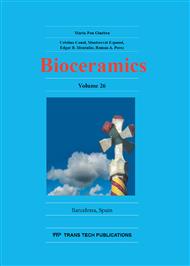p.402
p.408
p.414
p.420
p.426
p.430
p.435
p.443
p.448
In Vivo Osteogenesis Assessment of a Tricalcium Phosphate Paste and a Tricalcium Phosphate Foam Bone Grafting Materials
Abstract:
Calcium phosphates (CaPs) are synthetic bone grafting materials. CaPs are an alternative to overcome the drawbacks present with autologous bone grafting and/or xenograft materials. Among the CaPs, tricalcium phosphate (TCP) stands out as a good candidate due to its physicochemical properties. The clinical performance of β-TCP has already been proven and established. Nevertheless, the format in which TCP is delivered is also important in terms of clinical handling. This work assessed the in vivo performance of TCP-based bone grafting materials with different formats. Materials studied were a TCP paste (TCP-P), a TCP foam (TCP-F) and TCP granules (TCP-G). A sheep scapula model was used to evaluate the osteogenic performance of these bone grafting materials. All materials performed well in terms of bone regenerative capacity and material resorption. However, TCP-P and TCP-F displayed a more pronounced initial material resorption and also exhibited better handling properties compared to TCP-G. TCP-based materials with improved handling properties, such as TCP-P and TCP-F, which at the same time possess the advantageous properties of β-TCP are suitable bone substitute materials for grafting and reconstruction of bone defects in numerous clinical applications.
Info:
Periodical:
Pages:
426-429
Citation:
Online since:
November 2014
Keywords:
Price:
Сopyright:
© 2015 Trans Tech Publications Ltd. All Rights Reserved
Share:
Citation:


